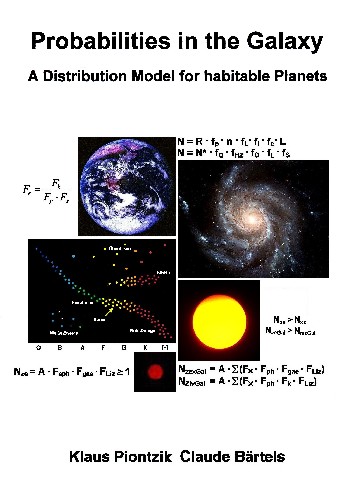As Chapter 9.4 shows, the Drake
equation can be considered as equivalent to the General
Basic Model 8.4.2 after fitting. For this to be exactly
the case, both equations must be equivalent to each
other.
| 8.8.4
General Basic Model: |
NzexGal
= A · Fph
· Fgae ·
FLiz |
| 9.2.2
Transformed Drake-Equation: |
N = R · Fp
· FLiz
· L |
It must then apply:
| NzexGal
|
= N |
| A·Fph·Fgae·FLiz |
=
R · Fp
· FLiz
· L |
| A·Fh·Fgae |
=
R · L |
| |
|
| 9.5.1 Equation |
A · Fh
· Fgae=
R · L |
Equation 9.5.1 can be used in
several ways to check and correct the parameters. Here Fe
offers the probability for earth-like planets:
| Fgae |
= R · L / (A·Fh) |
| Fe |
=
R · L / (A·Fh·Fga) |
| Fe |
=
R · L / (A·Fh·Fg·Fa) |
Fe = 400,000 · 11.5 /
(100-300)·109 · 10:603 ·1,212:3,286 · 51:130
Fe = 0.019,169 – 0.006,389
Fe =
1:52 – 1:156
This results in the earth similarity Fgae:
Fgae = 1,212:3,286 · 51:130 · (1:52 –
1:156)
Fgae
= 1:359 – 1:1078
With equation 9.5.1 the total number of stars in the
galaxy can be determined:
| A·Fh·Fgae |
= R · L |
| A |
=
R · L/ (A·Fh·Fgae) |
A · Fh · Fgae
= R · L
A = R · L / (Fh · Fgae)
A = 400,000 · 11.5 / 10:603 · 1:359 = 99.579 ·
109
A = 400,000 · 11.5 / 10:603 · 1:1078 = 299.015
· 109
This is in line with the given limits.
There are two ways to solve the equation. Solving the
equation according to L or R.
Possibility 1
L = A · Fh · Fgae / R
L = (100-300)·109 · 10:603 · 1:359 : 11.5 =
401,689 – 1,205,068
L = (100-300)·109 · 10:603 · 1:1078 : 11.5
= 133,772 – 401,316
On average, the life span of a civilization is:
L = 267,730 – 803,192 years
This results in the average life span of a civilization:
Lm =
535,461 years
This allows a correction for Axiom 7.2.1 to the lifetime
of a civilization:
| 9.5.2 Axiom |
The average life span of a
technological civilization is estimated at L =
535,000 ± 267,000 years. |
The maximum limits of a
civilization's life span:
L = 133,000 – 1,205,000 years
This is well in line with the 1.15 million year cycle of
civilisation in Chapter 7.4. The new maximum value allows
a correction for Axiom 7.2.2 to the age of a
civilization:
| 9.5.3 Axiom |
An old civilization is a
culture that is at least 1.2 million years old. |
Possibility 2
R = A
· Fh · Fgae
/ L
R = (100-300)·109 · 10:603 · 1:359 :
535.461 = 8.627 – 25.881
R = (100-300)·109 · 10:603 · 1:1.078 :
535.461 = 2.873 – 8.619
On average, the star formation rate is:
R = 5.75 – 17.25
This results in the average star formation rate:
R = 11.5
This is exactly the same as the given mean value.
This observation allows to make a correction for the
Drake equation. Insert the new values into equation
9.1.2:
N = (1.45-19) · 201:14,000 · 1:9 · 1:111.203 ·
535,461
N = 11 - 146 extraterrestrial technological
civilizations
| 9.5.4 Theorem |
There
are probably 11 to 146 technological
civilizations in our galaxy. |
This result will be referred to as
the corrected Drake equation.
|
